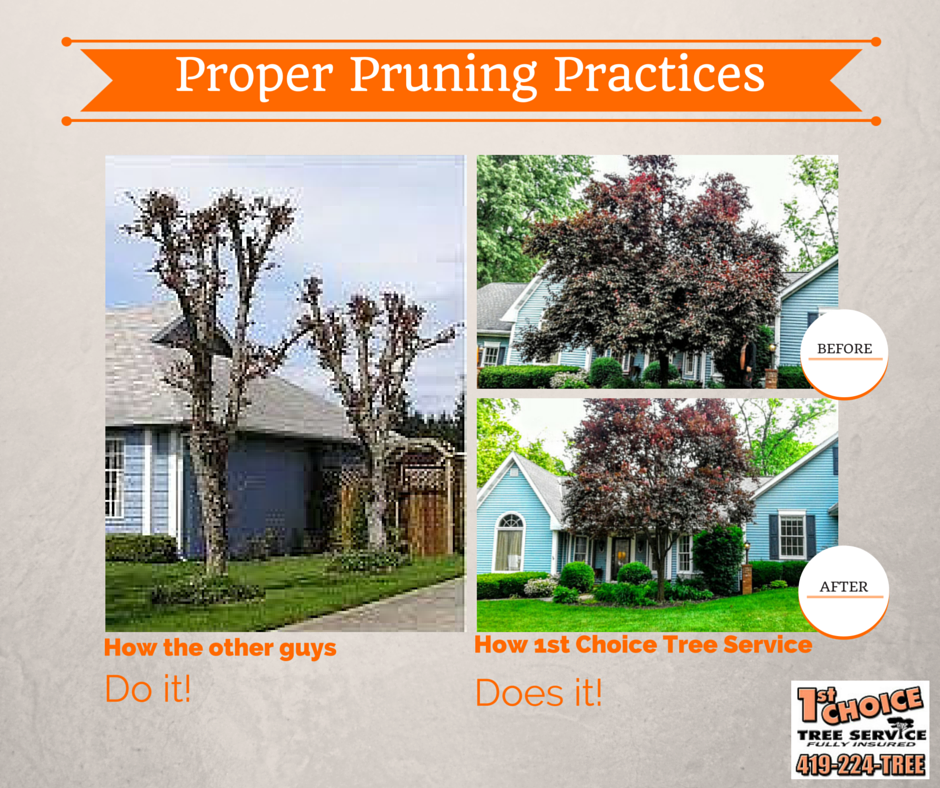If you live in the City of Lima, you could be eligible for the tree rebate program. Contact Alaina Morman for details, 419-223-0040 x110.
1 Comment
It's important to hire a professional tree care company who is educated in how to properly prune your trees. This shows you first hand the difference between proper pruning and tree hacking. Proper pruning techniques keeps your trees healthy and cosmetically appealing. When a tree is trimmed properly it will always compliment your landscape and your tree will remain strong for years to come. On the contrary, improper cuts will damage your tree, initiate decline and leave your tree as a visual eye sore.
Trees purchased from nurseries are often delivered in a pot or container. These instructions are for planting containerized trees.
You can print these instructions to take with you. Instructions1. Dig a hole 3 to 4 times wider than the container. The hole should have sloping sides like a saucer to allow for proper root growth. 2. Carefully remove the tree from the container keeping the soil around the roots intact. It helps to tap the outside of the container to loosen the edge. Carefully slide the tree from the container. Don't yank the tree out of the container as this can separate the roots from the tree. 3. Sometimes containerized trees become root-bound or the roots look like they're about to circle the root ball. If your tree is like this, cut an X across the bottom of the root ball and four vertical slices along the sides of the root ball with a sharp knife. 4. Set the tree in the middle of the hole. Avoid planting the tree too deep. If the root collar sits below the top of the hole, compact some soil under the tree so that the root flare at the base of the trunk is slightly above ground level. Using some soil, secure the tree in a straight position, then fill and firmly pack the hole with the original soil, making sure there aren't any air pockets. Keep backfilling until the soil is just below the root collar. 5. Create a water-holding basin around the hole and give the tree a good watering. After the water has soaked in, spread protective mulch 2–4 inches deep in a 3-foot diameter area around the base of the tree, but not touching the trunk. 6. The soil and mulch around your trees should be kept moist but not soggy. During dry weather, generously water the tree every 7 to 10 days during the first year. Water slowly at the dripline. 7. Remove any tags and labels from the tree as these will affect the tree as it grows. You may need to prune any broken or dead branches. (Please refer to the arborday.org pruning guide.) Fertilizer? Do not use fertilizer, potting soil, or chemicals on your newly planted trees. Such products will kill your young trees. Watering: Keeping your trees watered is important during their first year. Keep the soil and mulch moist but not soggy. In dry weather, you should water generously every 7–10 days. The water should soak into the soil and mulch. Avoid watering so much that you see standing water. Planting a Different Kind of Tree? Bare Root Balled & Burlapped Information taken from: www.arborday.org Tree roots are inscrutable. While their importance to the aboveground parts of trees and forests is well appreciated by forest scientists, tree roots have always been notoriously difficult to study, obscured as they are by duff, soil, rocks, and darkness. And that’s just in summer; the problem is only exacerbated by winter’s snow and frozen soil. Consequently, while researchers literally have been pondering roots for centuries, there is very little direct documentation of tree root activity in winter.
Still, forest ecologists are a curious and plucky bunch. They continue to build on that legacy of effort, by measuring roots of container-grown trees, painstakingly excavating living roots in forests, and, more recently, using modern imaging technology to watch roots grow in place. And most have come to agree on a generalized view of tree roots through the seasons. These ecologists describe root activity as periodic, with maximum growth in early summer – especially in deciduous species – and pulses of additional growth occurring occasionally in early fall. And complicating things further, they indicate that not all roots grow at the same time. Even within a single tree, some roots may be active while others are not. However, by all accounts, tree roots in our region are thought to spend the winter in a condition of dormancy. This means they are not dead but rather they overwinter in a resting phase with essential life processes continuing at a minimal rate. Full-on root growth resumes in spring, shortly after soils become free of frost, usually sometime before bud break. But unlike the aboveground parts of most trees that pass the winter in a prolonged dormancy – marked by unbroken inactivity until spring – tree roots seem to maintain a readiness to grow independent of the aboveground parts of the tree. That is, roots remain mostly inactive but can and do function and grow during winter months whenever soil temperatures are favorable, even if the air aboveground is brutally cold. While roots tend to freeze and die at soil temperatures below 20°F, minimum temperatures for root growth are thought to be between 32 and 41°F. So, if soil temperatures warm to or stay above this minimum, winter roots can break dormancy and become active. This winter quiescence – where roots are resting but ready – is extremely important for the health of individual trees and, by extension, for forests in general. Indeed, it is this trait that allows evergreens to absorb soil water and avoid winter desiccation in their needles, and it is this trait that allows all species, including deciduous hardwoods, the opportunity to expand their root systems in search of water and nutrients in advance of spring bud break. But there is an important tradeoff. To maintain this quiescence, a tree’s roots necessarily tend to be much less cold hardy than its stems and branches. This is fine, so long as the soil is sufficiently insulated by a covering of snow against extremely low air temperatures. A good early season snowfall – if it persists – can keep soil unfrozen throughout the coldest of winters. In such years, sustained winter root activity may replace previously damaged roots, may ready the tree for spring bud break, and may translate into excellent aboveground growth during the following summer. Conversely, a deep snowpack coming later in winter, after the soil is already frozen, can also insulate the soil – but in a different way. These late snows actually keep soil frozen for extended periods – even during January thaws and despite the heat of the earth’s core. The surface layers of forest soils do commonly freeze, and when they do, it is not good for roots or the stems and branches dependent on them. Not only do the roots remain inactive under such frozen conditions, but the freezing, heaving, and cracking of winter soils physically damages roots – particularly the fine feeder roots in the uppermost organic layers. This can trigger a cascade of effects on overall tree and forest health. By reducing a tree’s ability to take up water and nutrients, particularly during spring bud break, winter root damage limits subsequent stem and branch growth in summer. In turn, this can contribute to tree mortality and may even explain pockets of dead trees. Winter injury to feeder roots is an inherent – and natural – part of forests in northern climates. And, through its effects on individual tree health, winter root ecology is an important determinant of overall forest composition, dynamics, and productivity – even though it is difficult to see and measure directly. Michael Snyder is the Chittenden (Vermont) County Forester. 1) Fall fertilization:With a hot summer and cold winter, trees are bound to lose vital nutrients in the soil. To help make sure your trees gain nutrients lost this summer and continue to feed over the winter, apply a slow-release fertilizer to replace nutrients and improve resistance to damage from disease, insects and stressful weather.
2.) Hearty hydration: Fall is the season to give your trees a hearty gulp of water before the winter months strike. To make sure they are well-hydrated throughout the freezing winter, quench your trees’ roots. Subsurfacing watering is an efficient way to reach the tree's roots. Using an injection probe, water is distributed throughout the top 12 inches of soil— the area your trees need water the most. The subsurface watering method is ideal for trees and shrubs without irrigation systems, newly planted trees and trees that need temporary relief from drought stress. 3.) Timely planting: Some trees shed their leaves in autumn and sprout new life in the spring, but fall is actually the opportune time to plant new tree. Since temperatures are much cooler and there is much less chance of stress from sun scorch, drought or extremely high temperatures, newly planted trees get the chance to build root mass and prepare for winter dormancy this season. 4.) Equip for the cold: You know winter will arrive after fall, so start preparing now for the snow, frost and cold temperatures. Any sort of extreme weather condition may pose a higher risk of stress for your trees, so cable, brace and prune them before the snow and ice hit. If your tree has weakened or has broken or rotting branches, it may not be strong enough to withstand the added weight of a heavy snowfall or ice storm. Pruning in fall can be easier because most trees have little to no leaves, exposing the structure underneath. Next time you're out driving or simply out for a stroll, take a look around. Take a look at the trees in our community. I believe strongly that trees speak volumes about a particular community. Our city's trees, landscape and environment radiate and induce an attitude. What do our trees say about us?
|
Sarah H.Co-Owner Archives
May 2017
Categories
All
|

|
|


 RSS Feed
RSS Feed